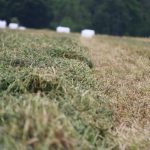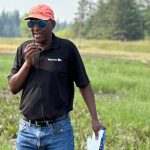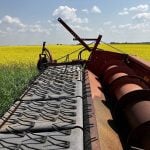This year’s wet weather was not only hard on farmers, but also their soil – and that’s why it’s especially important to soil test this year, according to the dean of Alberta’s soil scientists.
“This has been such an oddball year, it’s incredibly challenging to figure what’s left in the soil for next year’s crop, or where those nutrients are in the soil profile,” says Ross McKenzie, agronomy research scientist with Alberta Agriculture. “These things depend on how much precipitation was received, when it came, and the soil texture – the relative amounts of clay and sand.”
Read Also

Hail research hopes to benefit potato growers
Alberta research scientist measures hail storm and heat dome affects on potato crops
On sandier soil types, excess moisture may have leached the mobile soil nutrients, such as nitrates and sulphates, deeper into the soil profile. If soil was saturated for a time, or even various times, the soil environment would have favoured anaerobic bacteria, which thrive where there’s no oxygen. Some of these, the denitrifying bacteria, strip the oxygen from nitrate-nitrogen and use it for respiration, transforming the nitrates into nitrous oxide, a potent greenhouse gas which would have escaped the soil and been lost into the atmosphere.
Nitrogen that was in the soil in the ammonium form has a positive charge that binds it to negatively charged soil particles – clay and organic matter, and so it is protected from leaching. In warm soil with good moisture conditions, aerobic bacteria, which need air, oxidize ammonium to negatively charged nitrate. This is the form of nitrogen that is used by plants, but it’s also subject to both leaching and denitrification if soil conditions are wet enough. Leaching is a greater problem in sandy loam soils and denitrification is a greater problem in loam to clay loam soil types.
Topography had a big effect on soil conditions this year. Low spots, especially those that were under water at times, likely had much more denitrification than other field areas, says McKenzie. On the other hand, if there was any water erosion, the low parts of the field could have received organic material and phosphorus from higher areas via overland run-off and flooding.
The long, warm fall also has an effect on nutrient levels. Warm moist soils favour microbes which break down organic material built up over years of direct seeding. This mineralization of the light fraction, or labile, portion of soil organic matter releases nitrogen, phosphorus and sulphur into the soil in a plant-available form.
“Soil conditions have been so dynamic this year, it’s impossible to predict their nutrient status,” says McKenzie. “So this year, even more than any other I’ve seen, you need to soil test either in late fall or early next spring.”
Sampling procedures
This is also a year to take special care with your soil sampling, says McKenzie. He recommends using a soil auger or soil probe, rather than a shovel, to obtain better soil samples. McKenzie also says you should separate the samples from the zero to six-inch, six-to12-inch, and 12-and 24-inch depths. He recommends taking 20 to 25 cores for a quarter section.
“The top six inches of soil on one acre weighs about two million pounds,” says McKenzie. “That’s 320 million pounds for a quarter section. If you’re going to send a one-pound sample to a lab for testing that much soil, it should have good representation of soil from across the field. Four or five cores for a quarter are never enough and could be very misleading if they are not representative of the field.”
This year, to account for the extremes and changing moisture conditions, McKenzie recommends collecting separate samples from higher and lower parts of a field.
“Looking at the three depths and at upper and lower slopes – is really important this year,” says McKenzie. “Better to do all of them from several typical fields than to put together a soil sample that isn’t representative or doesn’t represent an identifiable zone. You need information on the nutrients that are available for a seedling, a growing, and a more mature plant, whether it’s on high ground or a lower area. That’s the only way to have any idea what nutrient levels are left after this year.”
Once you’ve taken the samples and allowed them to dry in a clean, cool place where animals can’t get at them, send them to a lab that uses the modified Kelowna method to estimate phosphorus, advises McKenzie. That’s the best way to test for phosphorus. It’s been well calibrated for Alberta soils.
Phosphorus is bound to soil in complex ways that are different in different soil types and each phosphorus extraction method works differently, depending on the soil’s chemical and physical properties. The results from each chemical method used by a lab have to be related to crop growth in the area where it’s used. That means years of crop nutrient trials showing the yield benefit from crop nutrients to calibrate the soil test method.
“No matter how high the lab standards, its results are not useful unless they’re calibrated to local soils,” says McKenzie.
———
“Soil conditions have been so dynamic this year, it’s impossible to predict their nutrient status.”
ROSS MCKENZIE
AGRONOMY RESEARCH SCIENTIST














